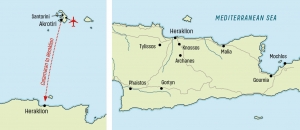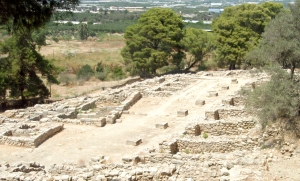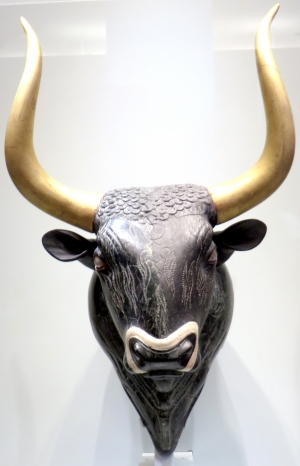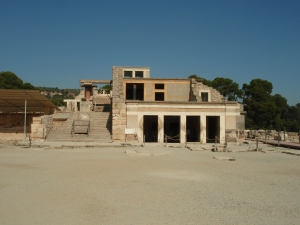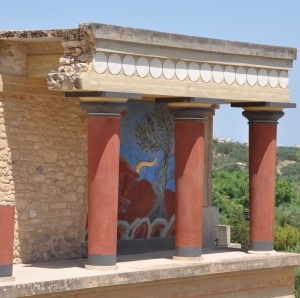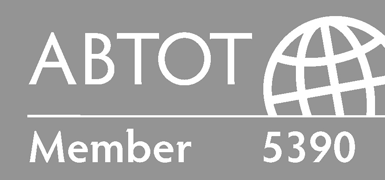
Crete & Santorini
The Lost World of The Minoans
To be confirmed
Crete & Santorini
The Lost World of The Minoans
Tour Introduction
On this tour we will explore the sites and discuss the evidence which give rise to the question: what was the Minoan civilization and what led to its demise? We travel to Crete, the island at the crossroads of three continents which has held such an important role in the Mediterranean at many times, both ancient and modern. We visit the extensive heritage of this fascinating island, prized by major powers from the third millennium BC, through the cultures of Minoans, Mycenaeans, Romans, Byzantines, Venetians, and Ottomans.
We also cross to the spectacular island of Thira (Santorini), with its important Bronze Age, Hellenistic, Roman and Byzantine sites, set in truly stunning volcanic scenery, and so central to the mystery of the Minoans.
Background
The lost world of the Minoans has intrigued people for thousands of years. Europe’s first great civilisation, an advanced society of artisans and skilled civic engineers with a maritime empire so vast it rivalled that of the ancient Egyptians, was inexplicably, and at the height of its power, wiped from the pages of history.
The predominant theory regarding the destruction of the Minoan Civilization has been that it was provoked by something as violent and as sudden as the eruption of Santorini Volcano. And ever since Sir Arthur Evans discovered the lost Palace of King Minos in Crete, archaeologists and scientists have been trying to connect the two events. In the summer of 1988, however, archaeologists digging on the island of Mochlos in Crete uncovered architectural and ceramic remains indicating that the civilization continued to flourish for some 150 years after the eruption in about 1600 B.C. With the new discovery, archaeologists find themselves searching for an alternative explanation for the sudden fall of the Minoan civilization around 1450 B.C. If the Theran volcano was not to blame, what then did bring about the fall of the Minoans?
Highlights
- In the company of an expert historian and specialist on ancient Crete
- Visit the amazing palace of Knossos, legendary site of the Labyrinth
- Explore the history of the ancient Minoans at the sites of Phaistos, Agia Triada, Malia, Tylissos, Akrotiri and Gournia
- View amazing artefacts at the Heraklion Archaeology Museum and newly opened Messara Museum
- Enjoy a boat trip to the Minoan site of Mochlos island (weather permitting)
What's Included
- 3 & 4 Star Hotels
- Return flights from London (optional)
- Expert historians throughout providing a daily variety of talks, presentations and Q&A
- Dedicated Tour Manager
- Dinner parties hosted by your expert historians and tour manager
- The company of like-minded travelers
- Helpful and friendly travel advice
- Meals as indicated in the itinerary
- Access to the Cultural Experience app
- Two drinks i,e wine or beer at each dinner and a welcome drink on first evening
- Entrance fees for sites included in itinerary
- Tour information booklet
- Modern, comfortable, air-conditioned coach
Itinerary
Day 1
Depart: Fly London to Heraklion. (D).
Day 2
Agia Triada, Phaistos and the Messara Museum: Crossing the imposing island spine, we travel south to Agia Triada where some of the most important artefacts of the Minoan period were excavated, including the only stone sarcophagus ever to be found on Crete. We then travel the short distance to the interesting Minoan site of Phaistos with its royal palaces, wide community spaces, cascading steps, official buildings, seemingly boundless magazines and views across the lush Messara valley. This was the second largest Minoan palace after Knossos and site of the discovery of the mysterious Phaistos Disk, now in the Herakalion Museum. After lunch we continue to the newly opened Messara Museum with its fabulous collection of objects from the area. Return to Heraklion. (B, L, D).
Day 3
Day trip to Santorini. Today we cross by catamaran over to the volcanic island of Santorini enjoying its mesmerising setting as we near the port. We drive to Akrotiri, considered one of the most important prehistoric sites of the Aegean. Once immersed in volcanic debris this city has revealed some remarkable artefacts, art, and buildings, none more so than the three-storey so called ‘West House’. In the afternoon we visit the outstanding Prehistoric Museum in Fira Town where we can admire the best-preserved frescoes in Aegean art. Catamaran back to Heraklion. (B, L, D).
Day 4
Archanes. Today we drive the short distance to the lovely rustic market town of Archanes with its narrow, winding alleys and its own Minoan villa. We start the day at the Minoan tombs of Fourni and after lunch in the town visit the small museum housing minor Minoan finds including from the cemetery of Fourni. Return to Heraklion. (B, L, D).
Day 5
Knossos and Heraklion Archaeological Museum. This morning we drive out to Knossos, most famous of all Minoan sites, and principal centre of the Minoan civilisation. Here we explore this largest of the preserved Minoan palatial centres, with its hundreds of small, interconnected chambers, conjectured to have been the labyrinth of legend. We also marvel at the immense pithoi or storage jars which dot the site. We return to Heraklion to spend a few hours at its famous archaeological museum which superbly presents major finds from Knossos and other sites including a wealth of pottery, inscriptions, weapons, wall paintings and sculptures, demonstrating the level of sophistication found in the culture of the Minoans. For the rest of the day we enjoy a leisurely walking tour of the fascinating city of Heraklion in the company of our guide to learn about its multilayered history. (B, L, D).
Day 6
Agios Nikolaus and Malia: Today we drive to Agios Nikolaus where we visit the archaeological museum with its collection of grave goods from the early Minoan cemetery of Agia Fotia (3000-2300 BC) and finds from the Minoan palace of Malia. We then return to Malia, the summer coastal home to Knossos. This massive site is as impressive as its winter counterpart but benefits from little reconstruction. (B, L, D).
Day 7
Mochlos and Gournia. We travel along the stunning northern coastline of the island enjoying magnificent coastal views as we proceed to the picturesque coastal village of Mochlos from where (weather permitting) we take a short boat trip to its eponymous island. Dating from the Early Minoan period, its excavated remains and cemetery have revealed a wealth of constructed tombs. Here you may spy archaeological remnants shimmering beneath the surface of the waters. We then visit the remarkable site of Gournia where extensive remains provide one of the best examples of a Minoan town. (B, L, D).
Day 8
Idaion Antron, Tylissos and return home. Our last day on Crete starts with a dramatic drive up onto the slopes of Mount Ida to visit the cave of Idaion Antron, famous as the birthplace of Zeus, and pilgrimage site from Minoan to Roman times. From this lofty eyrie (1538m) the views of Crete are spectacular. We then descend to Tylissos, an ancient Minoan sanctuary and town, to explore the ruins of excavated houses lying quietly amidst stately Italian Pine Trees. This is a quiet site, in marked contrast to the crowds at contemporaneous Knossos, and a fitting finale to our tour of the amazing civilisation that was Minoan Crete. Return evening flight Heraklion to London. (B).
Recommended Reading List
- Abducting a General: The Kreipe Operation and SOE in Crete
- Architecture of Minoan Crete: Constructing Identity in the Aegean Bronze Age
- The Villa Ariadne Paperback

